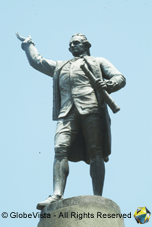
At thirteen James Cook had been a shop keeper’s assistant, but, preferring the sea, he had become an apprentice in a coal vessel. After man-years of the rough life in this trade, during which he contrived to carry on his education in mathematics and navigation, he entered the Royal Navy and by diligence rose to the rank of master. He had completed so many excellent surveys in North America and made himself so acquainted with astronomy, that the government had no hesitation in making him the leader in the 1769 expedition to the Pacific Ocean. He leads the expedition safely to Otaheite where they built fortifications and erected the instruments for observations. Having finished this part of the task, he set sail for new discoveries; and after visiting New Zealand, he reached the coast of Australia, a little south of Cape Howe.
Botany Bay
He continued to sail north-east along the coast until he reached a bay, where the ship anchored for about ten days. On his first landing, he was greeted by two natives, who seemed quite ready to encounter the forty or so armed men. Cook endeavoured to gain their respect but without success. A musket was fired between them, which startled them but did not dismay them. One of the men then fired some small shot into the legs of one of them and he ran into his hut only to return a few moments later with a shield. Cook made many subsequent attempts to be friendly with the natives but always without success (maybe they should have tried by not shooting at them!). Cook examined the country for a few miles inland while two of his scientific friends made collections of botanical specimens. Because the abundance of flora the place was called Botany Bay with its two headlands being named after the naturalists, Mr Banks and Dr Solander. it is here that Captain Cook, amid the firing of cannons and volleys of musketry, took possession of the country on behalf of His Britannic Majesty, giving it the name “New South Wales”, on account of the resemblance of its coasts to the southern shores of Wales.
Trouble Strikes the Expedition
Shortly after they had set sail from Botany Bay they observed a small opening in the land, but Cook did not stay to examine it, merely marking it on his charts as “Port Jackson”, in honour of his friend Sir George Jackson. The vessel still continued her course, northward along the coast, until they anchored in Moreton Bay. After a short stay they again set out towards the north, making a rough chart of the shores they saw. By this time they had sailed some 1300 miles without a mishap. But one night, about 11 o’clock, they found the sea growing very shallow; all hands were quickly on deck, but before the ship could be turned she struck heavily on a sunken rock. No land was to be seen and they concluded that they must be stuck on a bank of coral. the vessel seemed to rest upon the ridge but as the swell of the ocean rolled past, she bumped very heavily. Most of the cannons and other heavy articles were thrown overboard in an attempt to float her off at daybreak.
Unfortunately, they had little success, so they worked hard all day to prepare for the evening tide. As the water rose the vessel floated off the coral bank. This was not the end of their woes, the sea was discovered pouring rapidly through the leaks. Even with four pumps constantly going they could scarcely keep her afloat. They worked hard day and night but the ship was slowly sinking. It was only when all seemed lost that someone came up with an ingenious idea of passing a sail below the Endeavour and pulling it tight over the leakage (like a bandage). Shortly after they spotted land, which Captain Cook called “Cape Tribulation”. He sailed the vessel into the mouth of a small river, which they called the Endeavour, and there careened her (turned the ship on its side). On examining the bottom, it was found that a great sharp rock had pierced a hole in her timbers, which would have sent to to the bottom of the ocean in spite of the pumps and sails, had it not been for a piece of coral which had broken off and remained firmly fixed in the vessel’s side. The ship was fully repaired, after a delay of two months, before proceeding northward along the coast to Cape York. They then sailed through Torres Straits making the discovery that New Guinea and Australia were not joined.
